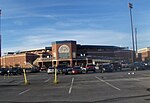Public School No. 19
1881 establishments in DelawareAC with 0 elementsDefunct high schools in DelawareDelaware Registered Historic Place stubsDelaware building and structure stubs ... and 6 more
Italianate architecture in DelawareNational Register of Historic Places in Wilmington, DelawareNortheastern United States school stubsSchool buildings completed in 1881School buildings on the National Register of Historic Places in DelawareSchools in Wilmington, Delaware

Public School No. 19, also known as St. Hedwig's High School, is a historic elementary school building located at Wilmington, New Castle County, Delaware. It was built in 1881, and is a two-story, cruciform-shaped brick building in the Italianate style. It has a low hipped roof and a heavy wood pediment is trimmed with elongated dentils and bracketed cornice returns. It operated as a public school until leased to St. Hedwig's Roman Catholic Church for use as a Catholic high school. St. Hedwig's High School closed in the 1970s and the building converted to offices.It was added to the National Register of Historic Places in 1984.
Excerpt from the Wikipedia article Public School No. 19 (License: CC BY-SA 3.0, Authors, Images).Public School No. 19
Oak Street, Wilmington
Geographical coordinates (GPS) Address External links Nearby Places Show on map
Geographical coordinates (GPS)
| Latitude | Longitude |
|---|---|
| N 39.73744 ° | E -75.568606 ° |
Address
Public School No. 19
Oak Street
19805 Wilmington
Delaware, United States
Open on Google Maps









